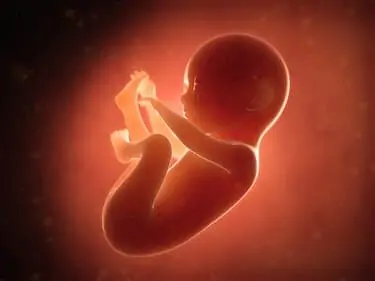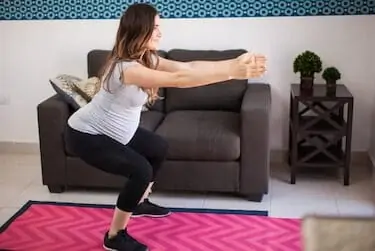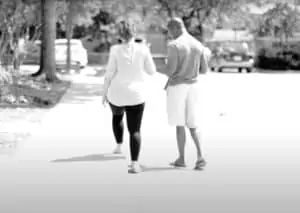The term “baby dropping” is something that made me wince when I first heard it. I thought it applied to actually dropping your baby while holding it, a fear of mine I’ve had since, well, since my friends started having babies.
In fact, I’ll never forget the first time I held a real, live baby. I was at my friend Billy’s house, and his sister-in-law was visiting. She held out a wiggly-jiggly 6-month-old baby girl and asked me if I wanted to hold her. I said, “Oh, noooo. But thanks! I don’t want to break her.” They all laughed at me and insisted I hold her anyway. “But what if I drop her?!?” I remember protesting. Again, they all laughed.
It wasn’t until I had my children that I realized how silly I sounded. But that encounter resulted in a baby smiling at me, and that smile made me realize that I’d like to be a mom someday. I certainly wasn’t ready at the time, though. Incidentally, that baby is now in high school!
Anyway, baby-dropping has nothing to do with having total butterfingers and dropping your baby onto the ground. It has everything to do with your baby making his or her way down into your pelvis to prepare for labor.
Here is the list of all uncommon signs of labor approaching.
Baby Dropping – What Is It?
Baby dropping happens when that little baby head starts its journey down into your pelvis. It’s also called lightening because it results in a lighter feeling for you, Mom. It happens at the end of the third trimester and is a sign that labor is getting closer.
But just wait! There’s no need to run off to the hospital yet.
A smart move instead would be to ensure you’ve got your hospital bags ready so that you won’t run about like a chicken with your head cut off when the time comes. Double-checking your bags is good if you’ve already got them ready. And just remember, should you forget something, someone can always bring it, so please try to stay calm.
Before your baby dropping, he or she may rotate, putting the back of the head toward the front of your belly with the head facing down. Then, down into the pelvis, your baby goes! Whether you feel it or not, your doctor will tell you it has engaged once it has settled into your pelvis.
When Can I Expect My Baby To Drop?

Unfortunately, there is no set time for your baby’s head to drop. This is why you’ll visit your doctor weekly toward the end of your pregnancy. He or she can tell you whether your baby has dropped if you didn’t feel it. The timing is different for every one of us.
When your baby drops, it’s a sign that you’re getting closer to labor, but there’s no clear timeline there how long it will take before you go into labor. In other words, it’s not a good predictor. For first-time moms, you can expect your baby to drop somewhere between 2 and 4 weeks before delivery, but it can also happen earlier.
For women who have already given birth, your baby may not even drop down into the pelvis until your labor begins. This is because your body has been through this process before, and your pelvis will require less time to get ready to birth your baby.
Keeping a lookout during your last month of pregnancy is wise if it’s your first rodeo. Again, your weekly doctor’s appointments will shed some light on what’s happening.
During my first pregnancy,
I remember my baby dropping in week 36. I remember feeling so much lighter then, though the feeling shifts a bit and starts getting uncomfortable the further your baby drops.
I gave birth to a healthy daughter at week 38, though I had friends who dropped in at week 36 and didn’t pop theirs out until week 40. I’ve also had friends with their first baby who didn’t drop until week 38 and popped in week 39. My best friend dropped in week 38 and was still pregnant at week 41. Her labor had to be induced.
I could list all my mom’s friends here and tell you our tales, but I think you get a general idea: it’s different for all of us, and just because one thing happens to your friend doesn’t mean it’s going to happen to you.
My Advice:
Just be prepared. Not worried…prepared. Because when it does happen, you’ll know you’ve got to get ready to expect that labor will come any time after this, though if your baby just dropped, chances are you’ve still got a bit of time before it’s go-time.
What Does Baby Dropping Feel Like?
When your baby drops, you may not even feel it happening. You may, however, notice that the shape of your abdomen has changed. For others, you may suddenly feel a very distinct and noticeable movement. Again, like the timeframe for your baby dropping and its relativity to labor, it’s all a great big surprise what you’re going to get.
Do you like surprises? If not, get ready!
Giving birth and parenthood are both full of surprises. Some are wonderful, others are not, like a disgusting diaper mess at 3 am.
If you feel anything, you may notice your abdomen feels lighter after your baby has dropped. With baby down in your pelvis, it makes more room in your middle, which is why it gets the name lightening. 🙂
For me, I didn’t feel my first daughter drop suddenly. I just noticed one day that I felt lighter in the middle. My checkup was the following day, and my doctor confirmed that she’d dropped. Again, for me, that was week 36, but for you, it could be totally different.
I felt fine until maybe 3 or 4 days before she was born. Looking back, I felt very uncomfortable between my legs, like I had a bowling ball. Many other women also describe this feeling, but some do not feel lighter like I did when the drop happened. They just felt that bowling-ball-sensation between their legs.
Our experiences are all different, so let me just say this: in the last few weeks of your pregnancy, you should really focus on just finding a way to be comfortable. You’ll thank me for that later!
Signs Your Baby Is Dropping
So, as I said, not every woman can feel their baby dropping. The question burning in your mind must be, “What are the signs my baby is dropping?” Of course, your doctor will confirm it at your next checkup, but if you experience any of these, you likely have a baby down in the pelvis, getting ready to push the labor alarm button to come on in the next week to a month!
- Lower belly
Even if you carry high during pregnancy, your bump will look lowered once your baby drops. If you don’t feel anything unusual toward the end, look in the mirror and see if your baby bump looks different.
- Pain from pelvis pressure
When your baby drops into the pelvis, depending on the station (which I’ll explain shortly), you may feel lighter from the dropping. At least initially. Once your baby settles in more, getting closer to the big day, the pressure in your pelvic area increases. If you waddle when you walk, your baby has dropped.
- Surges of pelvic pain
This won’t happen to every mom-to-be, but some of you will get these intense surges of pelvic pain. Doctors say it’s because your baby’s head is pushing on the ligaments in your pelvis. It’s very uncomfortable, which is why you should make sure to take it easy during this time to ease your pain.
- Ease of breathing
Let’s not focus on the pain, shall we? Let’s talk about something good that will happen when your baby drops. Like the fact that there is less pressure on your diaphragm. You’ll be able to breathe easier, which is such a relief!
- Hemorrhoids
Perhaps the last point isn’t going to make up for the next ones, but you must know about them. You may get hemorrhoids with pressure on your pelvic nerves and rectum. I’m so sorry! I know! It’s horrible, believe me. I was very lucky and never had them during my pregnancies, but I got them afterward. I STILL get them. You can ask your doctor to recommend a safe cream to relieve the pain.
- Increased discharge
This one didn’t happen to me because my birth was in the 15% of women whose water burst forth like a dam, just like in the movies. But for the rest of you, that increased pressure on your cervix will loosen that mucus plug which will gradually release in the form of a jelly-like or yolk-like discharge. It’s there to protect your uterus from harmful bacterial intruders, which is why if what happened to me happens to you, you must get to the hospital quickly to prevent any problems.
- Urgent, frequent need to pee
I can’t say this happened to me because, for both of my pregnancies, I felt like I constantly had to pee. In fact, I couldn’t even get to the bus stop down the end of our street without running into the bathroom in the restaurant at the bottom of the hill there. So my need to pee often didn’t change once my babies had dropped. It may, of course, be very different for you.
- Back pain
You’ve likely gotten used to many aches and pains during your pregnancy. Once the baby drops, get ready for more intense back pain. Again, I urge you to take it easy and consider it a success if you find a way to get into a comfortable position in your day.
- Reduces heartburn and increased hunger
Some women are lucky. You may experience fewer heartburn woes when your baby drops, and you feel hungrier. I still suffered from heartburn until the very end. That old wives’ tale about heartburn being related to how much hair your child is born with very well may be true (okay, so it’s not, but both my daughters had gobs of hair when they were born).
Fetal Stations In Labor
If you think your baby has dropped, you should make sure you’ve got an appointment with your doctor. He or she can use a fetal stations scale to determine your baby’s position.
The most commonly used is a five-point scale. Here’s the deal:

This system divides the pelvis by using ischial spine markers on your pelvis as indicators. The ischial spines are divided into fifths. When your baby drops and prepares for labor, the head becomes level with these ischial spines. The scale goes from -5 to +5; the further your baby goes down, the closer it is to being born.
This means that before your baby drops, the station will likely be at -5. Once it does drop and your doctor announces it is engaged, you may be at station zero. At the crowning, when your baby is making its way through your vagina during delivery, that’s station +5. Most women are at zero or lower station when fully dilated.
Unless you are me. 🙁
Then you will spend 24 hours in labor and not dilate nearly enough. My daughter also turned around inside of me, a very painful experience, but not to worry! What happened to me is much rarer. We couldn’t get her to turn, and she was nowhere near the right station, so I had an emergency c-section.
Don’t panic. Not yet, anyway. It won’t do you a bit of good. Just go for your exam, and your doctor will examine you down there to feel for the baby’s head and check out all those other things. This is not the time to be embarrassed. You’ll have tons of medical professionals looking at your lady bits, so relax and let them help you. 😀
How Can I Encourage My Baby To Drop?

If your due date is fast approaching, but your baby hasn’t dropped yet, you can do a few things to facilitate that descent. Try walking around your neighborhood or local park. That fresh air will also do you some good.
Or, at home, you can try squats, pelvic tilts, or sitting on a birthing ball. Just a word of caution with the squats…keep a hand on a steady surface, so you don’t wobble over. Your balance is severely compromised toward the end of your pregnancy.
Doing these things opens your hips and stretches those pelvic muscles, which encourages your baby to drop.
When Should I Worry About My Baby Dropping?
If your baby hasn’t dropped yet and you’re toward the end of your pregnancy, your doctor will be able to help. But if it has, you may wonder what’s normal and what’s not. Some pelvic pain is very normal once your baby has dropped.
What’s not normal is constant pain in the pelvis during this time. Random surges of pain usually happen but if you feel you’re in continuous pain, call your doctor immediately. Additionally, if that pain comes with bleeding, fluid loss, or a fever, you should tell your doctor immediately to help take care of you and your baby properly.
Leslie Berry lives with her husband and two young daughters in Los Altos, California, where she loves helping other moms get comfortable with motherhood and embracing the insanity with facts peppered with laughs.
She loves eating too much sushi, exercising, and jamming out on her Fender. Read more about Leslie here.






